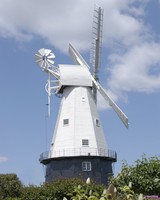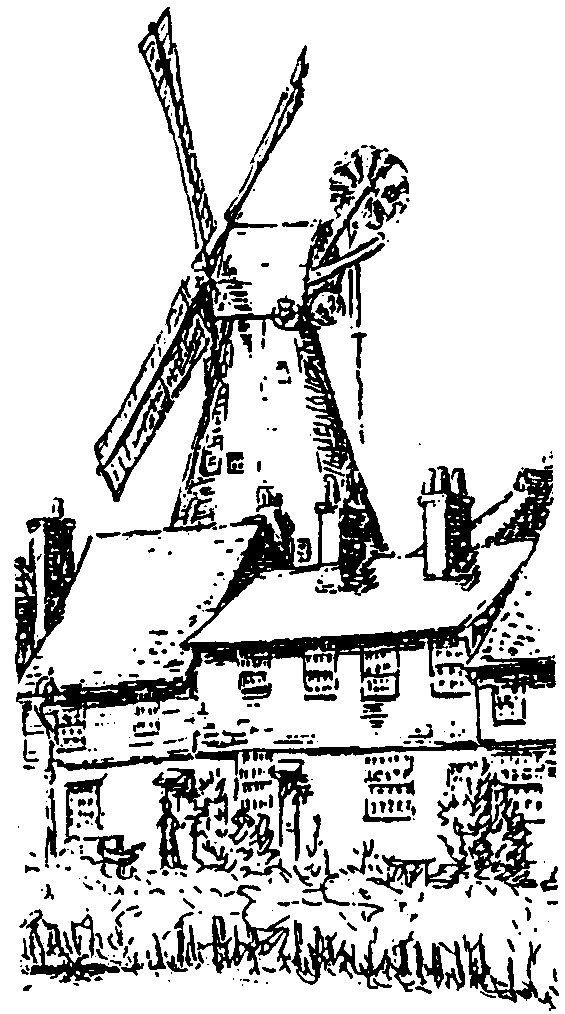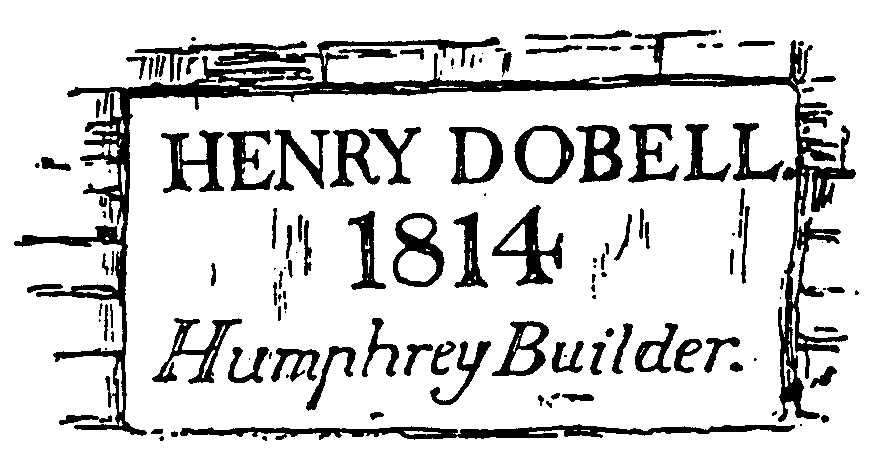
| Union Mill, Cranbrook Registered charity no.1031879
| |
|
The Dobells and the Union Mill Company
During the eighteenth century, there were great improvements in agriculture, spurred on by the industrial revolution and the demand for more food from the growing industrial towns. In the Weald, much of the land was woodland or pasture but more was brought under the plough for growing corn during the century and consequently more mills were needed for grinding the corn into flour. There were several water-mills within the parish boundaries although the streams were mostly small, but the outbreak of war with Napoleon in 1793 meant an increased demand for supplies for the army and navy. Thus the next 20 years were a prosperous time for farmers and millers. The 1801 Ordnance survey map shows only one windmill on Cranbrook Common (near Camden Lodge), but another was built further north in 1802 (north of Verralls garage). Perhaps their success inspired two more windmills to be built in 1814, one near to Three Chimneys (close to the parish boundary with Biddenden) and the other on the Hill, at the east end of the town. William Dobell was a tallow chandler, living on the Hill in Cranbrook in the late 18th century. He married his second wife, Mary Couchman in Benenden on 25th October 1788 (1) but died relatively young and was buried on 7th April 1799 (2). Mary must have been moderately well off as William had left her a tenanted farm on the Golford Road (now called "Paddocks") and houses and land on the Hill in Cranbrook, which included the house near the windmill now called "Greycoats" (3). They had four children, of whom Henry, born in 1791, was the second and Stephen was the third (4). Mary continued the tallow-chandler's business, going into partnership with her son Stephen (5) and built the windmill for Henry (6), who, presumably, had been apprenticed with a miller in the neighbourhood. The mill was first rated in her name in April 1815 with a rateable value of £15 but Henry took over as ratepayer in May 1816 (7). Henry must have felt that his future was assured and he married Susannah Boulden on 17th June 1816 in St.Dunstan's church, Cranbrook. In November 1818 the rateable value was increased to £20 but there is no rate assessment for the Dobell property in May 1819 and by the Autumn bankruptcy had been declared. The rate books give "Henry Dobell or occupier" in November but the rate was probably never paid. The slump which followed the end of the Napoleonic Wars hit agriculture badly and there was a nation-wide depression which lasted for at least a decade with reduced wages, much unemployment and great hardship in the countryside, resulting in the Swing Riots of 1832.  The Centre for Kentish Studies in Maidstone holds a deed (6) dated 11th Oct 1819 which is a copy of the conveyance and assignment of Mary Dobell's real and personal estates to three Cranbrook trustees, James Russell, gent, James Skinner, gent and Thomas Oyler, carpenter. James Skinner was the minister (from 1785 until his death in 1827) of the Chapel-on-the-Hill, which the Dobells attended and in whose registers the births of William and Mary's four children were recorded in the 1790s. The Dobell properties are listed in this conveyance and they include the windmill described as follows: "a wind cornmill ... lately now erected and built by and at the costs and charges of the said Mary Dobell ... at a place called the Hill in Cranbrook now occupied by Mary Dobell". In addition to the land and buildings, Mary Dobell was obliged to sell "all stock in trade, stock alive and dead, farm implements and effects whatsoever and wheresoever ... And all the Household Furniture, Plate, Linen and China Goods, Wares, Merchandizes, Book and other Debts, Bills, Notes, and Securities” and all her goods and chattels “except her wearing apparrel”. So all she was left with was her clothes. The deed cites three outstanding mortgages of £1000, £600, and £600 with interest, having first call on the proceeds from the sale of the property; no names of the mortgagees are given but presumably they were the three trustees mentioned above since they had the most to lose and it seems likely that the money was borrowed from them to pay for the construction of the windmill and a cottage nearby (see later). The three trustees inserted notices in the Maidstone Journal shortly after (5), requesting claims from any creditors of Mary Dobell. There was also a notice announcing the dissolving of the partnership of Mrs Mary Dobell and Stephen Dobell, tallow chandlers, presumably to protect Stephen's personal estate from claims when settling Mary's debts. It is interesting to note that one of the witnesses to this declaration is James Humphreys, the millwright who built the windmill for Mary. Then came the advertisements for the auction of Mary's real estate, the farm, and the cottages on the Hill, although it did not include the windmill (first two lots only included).
The jogging screen was used to clean the grain before milling by sieving out any stalks, chaff, and foreign matter. French burr stones are used in mills when white flour is required, as the bran, the outer "skin" of the grain, is not ground so finely as by peak stones. Consequently, when the wholemeal flour produced by these millstones is passed through the bolter or the flour machine to produce white flour, its removal is much easier. The Union Mill Company was still recorded as the ratepayer in June 1832 but by the following October, the sale had been concluded and John & George Russell, from Waldron and Chiddingly in Sussex, were the new owners and paid the rates. Mary Dobell lived for a few years after her bankruptcy, watching her creditors trying to make a profit from her
investment but she was buried on 9th June 1825, aged 66. Henry, however, survived to see the mill's
fortunes revived and the Russells take over, while he struggled to find work elsewhere. After his short rise to
fame as the miller at the newest and grandest windmill in Cranbrook - possibly in Kent(?) - the rapid change in economic climate
sadly reduced him to more menial occupations and he soon disappeared from Kent records. He is not
listed in the 1841 census for Cranbrook but by 1851 census, he must have fallen on hard times and returned to his parish of settlement because he was then resident in Cranbrook Union workhouse at Hartley. By this date he was 60 years old and probably still reasonably able-bodied
and would have been obliged to do some work to help pay for his keep. In the census he is described as
"labourer nurse", suggesting that he may have been assisting in the infirmary. The entry in St.Dunstan's
burial register does not say whether he died in the workhouse but reads:
After starting his working life with such high hopes, Henry must have died a greatly disappointed man. Tony Singleton; Illustrations by Peggy Fryer
References (CKS = The Centre for Kentish Studies): Read about how John and George Russell prospered with the mill |
